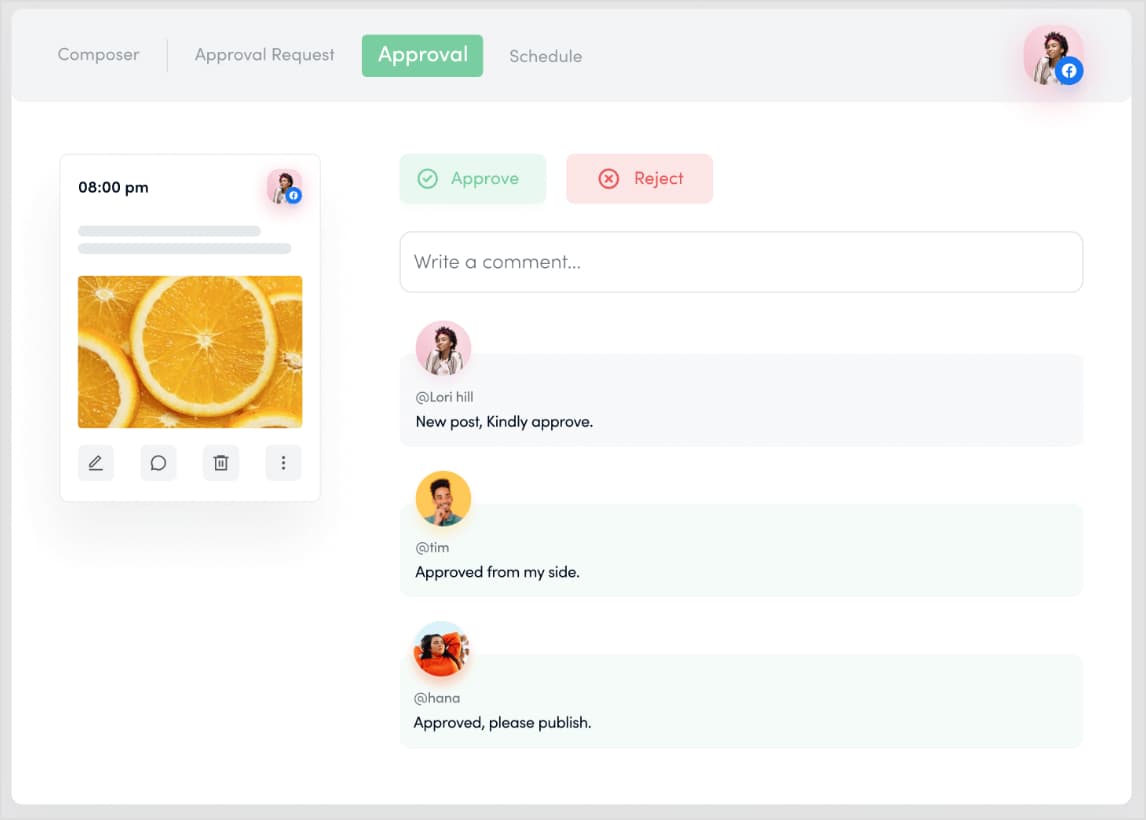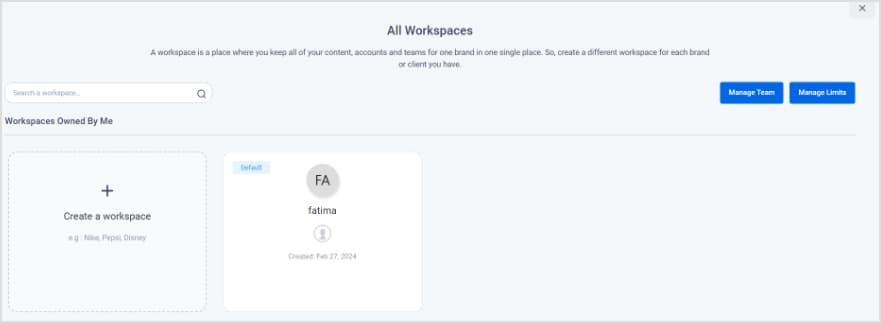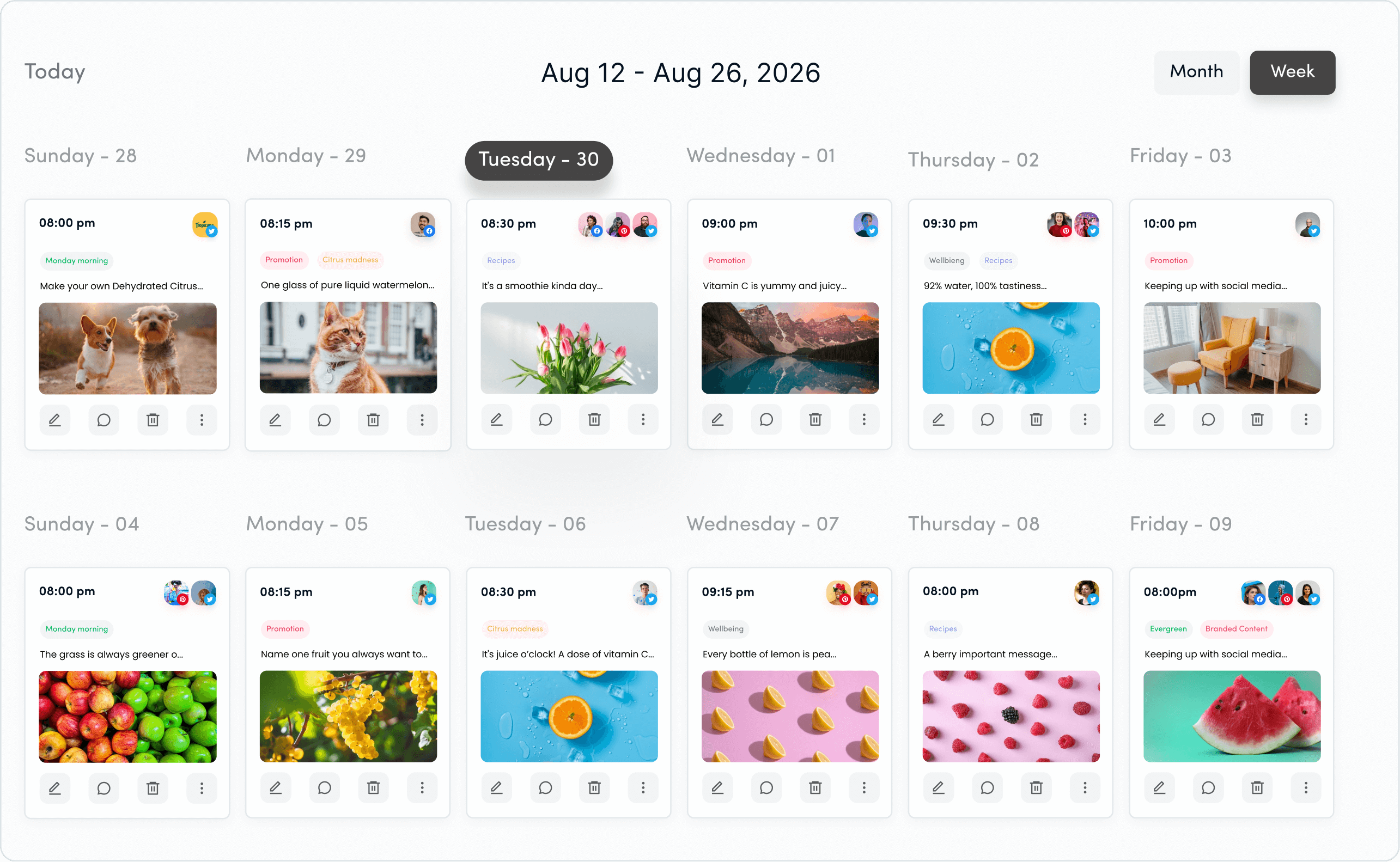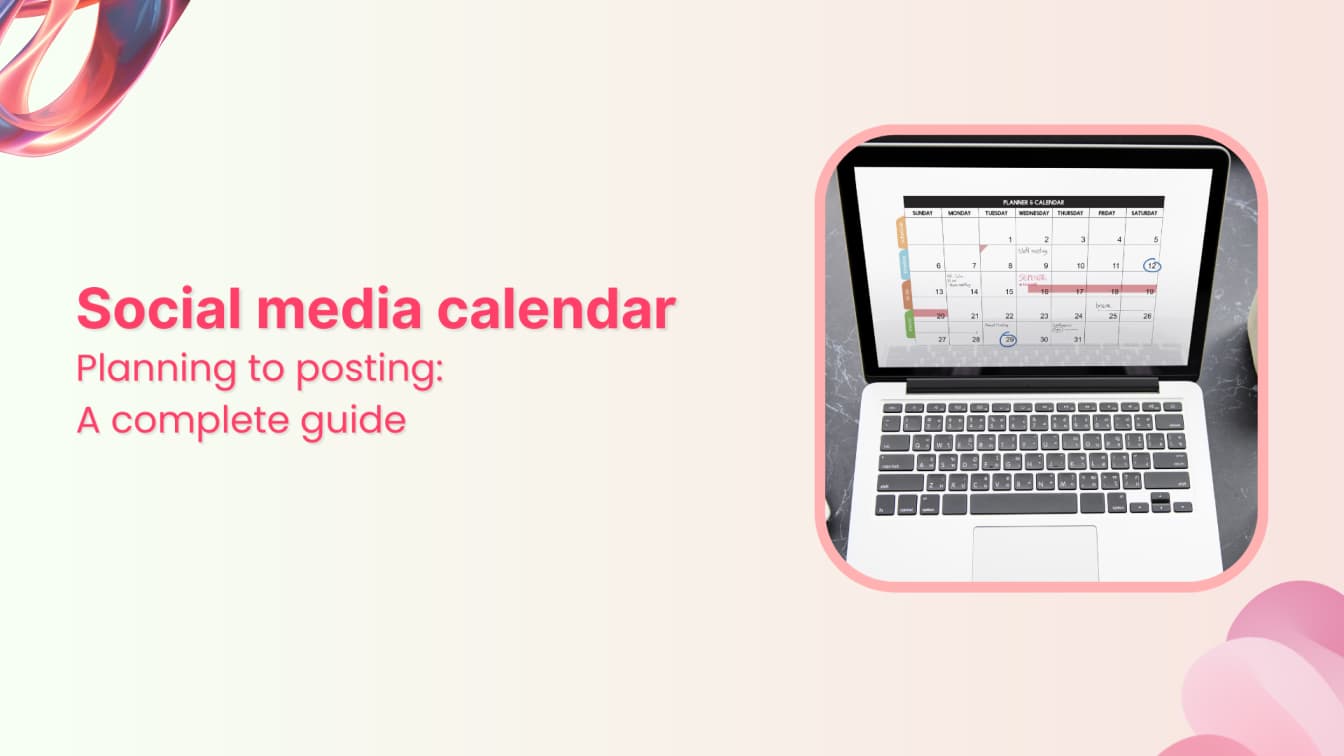Have you ever scrambled at the last minute to find the perfect post for your social media channel? A well-crafted social media calendar is the perfect solution for marketers to juggle between multiple platforms and manage a consistent posting schedule.
A social media calendar helps streamline your content strategy by organizing what to post, where, and when. By planning ahead, you can focus on quality content, align your posts with business goals, and ensure your campaigns stay on track.
Whether you’re a small business owner or part of a larger marketing team, adopting a structured approach to social media can make all the difference. This guide will walk you through understanding, creating, and leveraging a social media calendar effectively.
What is a social media calendar?
A social media calendar is a tool that helps marketers plan and organize their content for various platforms. It provides a clear, structured schedule of upcoming posts, complete with details like publish date and time, captions, hashtags, links, and accompanying visuals. This calendar acts as a roadmap, ensuring consistency and alignment with broader marketing goals.
For example, consider a retail brand planning a new product launch. Using a social media calendar, they can coordinate posts across Instagram, Facebook, and Twitter to build anticipation. Posts might include teaser images a week before the launch, a live Q&A session on Instagram the day prior, and a detailed product announcement on launch day.
Each post can be scheduled using a reliable social media management tool like ContentStudio, ensuring smooth execution.
Social media calendars can take many forms, such as spreadsheets, project management tools, or comprehensive platforms like ContentStudio.
These tools not only help marketers schedule and organize posts but also offer additional features like AI-generated captions, multi-channel analytics, and unified inboxes to streamline content creation and audience engagement.
By leveraging such platforms, marketers can ensure their social media strategies remain cohesive, timely, and impactful.
Reasons to opt for a social media calendar
A social media calendar is more than a tool—it’s the backbone of an effective social media strategy. It keeps your content organized, ensures consistency, and saves time for teams managing multiple accounts or campaigns.
Let’s explore six compelling reasons why adopting a social media calendar is essential for your content marketing plan.
1. Save Time and boost efficiency
Managing social media requires daily attention to trends, audience engagement, and content creation. Without a calendar, the process can become chaotic and time-consuming.
A social media calendar streamlines your workflow by enabling you to batch-create content and schedule posts in advance. For instance, a retail brand launching a holiday sale can pre-plan festive posts for the entire month, freeing up time for real-time audience engagement. This forward-thinking approach not only saves time but also allows teams to focus on higher-value tasks like strategy refinement or performance analysis.
2. Maintain consistency across platforms
Consistency is key to building an engaged audience. A social media calendar helps you establish a regular posting cadence while maintaining a cohesive brand voice and style.
Consider a fitness brand that posts motivational quotes, workout tips, and client success stories. A calendar ensures these posts are spaced out evenly, avoiding content clusters followed by long periods of inactivity. This steady stream of content keeps the audience engaged and fosters trust, especially in industries where reliability is critical to customer loyalty.
3. Enhance collaboration across teams
Social media campaigns often involve input from multiple teams, including content creators, designers, and marketing managers. A calendar serves as a central hub, providing visibility into the content pipeline and deadlines.
For example, an eCommerce brand preparing a Black Friday campaign can use a calendar to align designers creating banners, writers drafting captions, and social managers scheduling posts. This transparency reduces last-minute rushes, ensures alignment with the broader campaign, and keeps all stakeholders on the same page.
4. Improve quality and mitigate risks
Rushed posts can lead to errors or reputational damage. A social media calendar allows for thorough planning and review, minimizing the risk of typos, missteps, or poorly timed content.
Take the example of a brand planning to participate in a trending conversation. Without proper context or timing, such attempts can backfire, as seen in cases where brands accidentally post insensitive content during global crises. A well-maintained calendar ensures there’s ample time for vetting and approvals, safeguarding the brand’s reputation.
5. Optimize campaign planning and execution
Social media calendars are invaluable for strategic initiatives like product launches, seasonal campaigns, or event promotions. By plotting key dates, milestones, and supporting content in advance, you can ensure seamless execution.
For instance, a tech company unveiling a new gadget can map out teaser posts, influencer collaborations, and launch-day announcements in the calendar. This structured approach guarantees that all campaign elements work in harmony, maximizing impact and audience reach.
6. Repurpose high-performing content
Tracking content in a calendar provides a valuable record of past performance, helping you identify successful posts that can be repurposed.
For example, a travel agency that shares breathtaking destination images might notice certain posts consistently perform well. These posts can be recycled with updated captions or used in email campaigns, saving resources while ensuring your audience continues to engage with proven content. Repurposing also helps maintain a steady flow of content, especially during slower periods.
Steps to create a social media calendar
Building an effective social media calendar can seem overwhelming at first, but breaking the process into clear steps makes it manageable and ensures your content strategy aligns with business goals.
Here’s a step-by-step guide to help you streamline the process and create a calendar that drives results.
Step 1: Conduct a social media audit
Before you begin, evaluate your current social media efforts to understand what’s working and what isn’t. An audit involves analyzing past posts, engagement metrics, audience preferences, and publishing habits.
Start by gathering key performance indicators (KPIs) for each platform, such as likes, shares, comments, and click-through rates. Identify high-performing posts and note patterns in topics or formats that resonate with your audience. Tools like ContentStudio can simplify this process with its multi-channel analytics, helping you monitor trends and benchmark against competitors.
For example, if videos consistently drive engagement on Instagram, your calendar should include more video content. Use the insights gained from this audit to identify content gaps, set goals, and establish a direction for your calendar.
Related: How to conduct a successful social media audit [+ free template]
Step 2: Choose your social media channels and content types
Decide which platforms are most relevant for your business and what content formats to prioritize. Different social networks cater to different audiences and content styles, so align your choices with your audience’s preferences.
For instance, TikTok thrives on short, entertaining videos, while LinkedIn favors professional, educational posts. Leverage ContentStudio’s content discovery feature to explore trending topics, hashtags, and formats across platforms. This ensures your content is not only relevant but also tailored to the unique requirements of each channel.
Develop a content mix that includes diverse formats like videos, images, carousels, and blog links. For example, a fitness brand might combine workout tutorials, client testimonials, and nutrition tips across Instagram, Facebook, and YouTube.

Step 3: Create a social media calendar template
A structured template helps organize your posts and provides a comprehensive view of your strategy. Your template should include:
- Date and time of publication
- Platform and account details
- Post captions, hashtags, and links
- Media assets (images, videos, etc.)
- Approval status and feedback notes
- Campaign associations
Tools like ContentStudio provide multi-channel content calendars, enabling you to plan posts visually and adjust timelines effortlessly. Additionally, features like UTM tracking and post preview capabilities help ensure posts align with campaign goals and appear correctly on each platform.

Step 4: Define a posting schedule
Consistency is critical to building audience trust and maintaining engagement. Use insights from your audit to determine the best posting times and frequencies for each platform.
ContentStudio’s Best Time to Post feature analyzes audience behavior to recommend ideal scheduling times for maximum visibility and engagement.
Establish a balanced schedule that avoids over-posting or neglecting platforms. For instance, aim for 3–5 Instagram posts per week, with 7–10 stories to maintain an active presence.

Step 5: Plan content creation and approval workflows
Once your schedule is in place, focus on creating high-quality, platform-specific content. Collaborate with your team to streamline the production process.
ContentStudio’s approval workflows make it easy to gather feedback, manage revisions, and ensure content meets brand guidelines before publishing. Assign tasks for copywriting, design, and scheduling to team members and use its live comment and approval features for efficient collaboration.
For instance, if you’re planning a product launch campaign, you can set up a workflow where the marketing team drafts posts, the design team creates visuals, and stakeholders review and approve them in one place.

Related: A comprehensive guide to create engaging content in 2025
Step 6: Schedule and automate posts
Scheduling posts in advance allows you to focus on strategy and audience engagement rather than day-to-day content management. ContentStudio’s automation recipes let you batch-schedule posts across multiple platforms, saving time and reducing manual work.
For example, use the Evergreen feature to automatically repost high-performing content at optimal intervals, keeping it visible to new followers. Similarly, its bulk upload option lets you schedule months’ worth of content using a simple CSV file, perfect for agencies or large teams managing multiple accounts.

Step 7: Monitor and analyze performance
Your social media calendar isn’t complete without tracking and evaluating the performance of your posts. Regular analysis helps identify what works, what doesn’t, and how you can improve.
ContentStudio’s analytics dashboard provides detailed performance reports across all your platforms, from audience engagement to traffic driven by specific posts. Use these insights to refine your strategy, adjust posting times, and experiment with new content types.
For instance, if analytics show a spike in engagement for behind-the-scenes videos, consider incorporating more of this format into your calendar.

Step 8: Update and iterate regularly
Social media trends and audience preferences evolve rapidly. Regularly revisit your calendar to make updates, refine your approach, and incorporate fresh ideas.
Involve other teams, like product development or customer service, for input on upcoming launches or frequently asked questions. ContentStudio’s workspace management feature allows you to create dedicated calendars for different campaigns or brands, ensuring each initiative stays organized and aligned with its goals.
For example, you might update your calendar to include Q&A sessions for a new product release or seasonal campaigns tied to upcoming holidays.

Best practices for social media calendar management
Effectively managing a social media calendar requires more than just planning; it demands regular updates, teamwork, and data-driven decisions. Here are actionable best practices to ensure your calendar remains efficient and impactful.
1. Regularly review analytics and update strategy
Use analytics to understand what resonates with your audience and adapt your calendar accordingly. Insights into engagement rates reach, and click-throughs can help you prioritize content types and formats.
For instance, if Instagram Stories perform better than feed posts, increase your focus on creating story-specific content. Many platforms, including native analytics tools like Facebook Insights or Twitter Analytics, provide actionable data for refining your approach.
Related: 15 best practices for crafting relatable content in 2025
2. Leave room for flexibility
While a structured calendar is essential, it’s important to remain adaptable to real-time trends and events. Keeping some slots open allows you to post about unexpected opportunities like viral challenges, breaking industry news, or relevant celebrations.
For example, during an industry event, you might post live updates or reactions, fostering audience engagement while staying timely and relevant.
3. Foster collaboration across teams
A social media calendar works best when multiple teams contribute their insights and expertise. Marketing, product, and customer service teams can all provide valuable input about campaigns, product launches, and FAQs.
Using shared tools or project management platforms ensures everyone is aligned on deadlines, responsibilities, and campaign goals.
4. Diversify content formats
Keep your content varied to maintain audience interest. Incorporate a mix of posts, such as educational infographics, entertaining videos, promotional carousels, and user-generated content.
For example, if you’re running a fitness page, you can plan workout tutorials, motivational quotes, and behind-the-scenes footage of training sessions. Spacing out these formats ensures your audience remains engaged without feeling overwhelmed by similar content.
5. Use clear labels and categories
Organize your calendar with labels that indicate post types, themes, or campaign goals. This makes it easy to track performance and identify gaps in your strategy.
For instance, assign labels like “promotional,” “engagement-focused,” or “educational” to each post. Color-coded systems can help visually distinguish these categories, making it easier to manage and analyze your calendar at a glance.
Related: Optimize your social strategy with ContentStudio’s label performance analytics
6. Automate repetitive tasks
Automation saves time and allows you to focus on creative tasks. Use a powerful social media automation tool to plan posts in advance and automate publishing at optimal times.
For instance, if your analytics indicate peak audience activity in the evenings, automation ensures your posts go live even when you’re offline. You can also set up recurring campaigns for evergreen content that stay relevant over time.
7. Maintain a centralized asset library
Having all your creative assets—images, videos, and templates—stored in one place ensures consistency and saves time during content creation.
Tools like Dropbox or Canva’s content library feature make it easy to access pre-approved assets for quick posting, ensuring your visuals align with your brand guidelines.
Related: Mastering social media asset management: Tips & tricks
8. Monitor competitor strategies
Keeping an eye on competitors can reveal gaps in your content strategy or inspire new ideas. Observe their posting frequency, content types, and engagement levels.
For example, if a competitor sees high engagement on polls or quizzes, consider integrating similar interactive content into your calendar to boost engagement.
9. Schedule regular check-ins and updates
Set a recurring schedule to review your social media calendar, ensuring it reflects new trends, campaigns, and audience feedback. A monthly or bi-weekly review allows you to pivot strategies effectively.
During these check-ins, revisit your KPIs, assess the effectiveness of recent posts, and make adjustments as needed. This proactive approach helps maintain relevance and maximize impact.
10. Track milestones and celebrate wins
Use your calendar to document key achievements, such as hitting follower milestones, successful campaigns, or high-performing posts.
For example, if a campaign significantly increases website traffic, note the strategies that contributed to its success. This practice not only boosts team morale but also provides a reference for future planning.e seeking a minimalist approach. Evaluate your requirements carefully to choose the tool that will best streamline your content strategy.
Top 5 tools to streamline your social media calendar
Managing a social media calendar can be a daunting task, especially for businesses juggling multiple platforms and content types. Fortunately, there are tools designed to simplify the process, improve collaboration, and ensure consistency.
Here are five top tools that can help you streamline your social media calendar.
1. ContentStudio: All-in-one social media management
ContentStudio is a robust social media management tool that combines content scheduling, collaboration, and analytics into a single platform. Tailored for agencies and large teams, it offers an intuitive calendar to plan, create, and manage posts effortlessly.

Key features:
- Unified content calendar: Plan and visualize content for multiple social media channels in one place. Use different views like Calendar, List, Feed, Instagrsam Grid, or TikTok Grid to customize how you organize posts.
- Approval workflows: Collaborate with teams and clients using built-in approval workflows, allowing for smooth feedback and revisions.
- Content categories and publishing queues: Organize your posts into categories such as educational, promotional, or user-generated content. Use publishing queues to automate post scheduling based on predefined categories.
- Digital asset library: Store and manage media files in a centralized library, making it easy to find and reuse assets.
- Advanced filters: Search and organize content by campaign, status, platform, or team member for improved accessibility.
Why choose ContentStudio?
Its blend of automation, collaboration, and analytics makes ContentStudio a standout choice for teams looking to manage complex social media strategies with ease. Whether you’re handling client accounts or internal campaigns, this tool ensures productivity and organization.
Plan, schedule, share, and analyze content for 15+ social media channels.
Try ContentStudio for FREE
2. Planable
Planable is built to streamline content creation, collaboration, and approval workflows. It’s perfect for teams that prioritize real-time collaboration and feedback.
Key features:
- Unified content workspace: Create and organize posts for multiple platforms in one dashboard.
- Real-time collaboration: Use live comments and approvals to ensure every team member is on the same page.
- Visual calendar: Drag and drop posts to adjust schedules and identify gaps in your strategy.
- Version history: Track changes and revert to previous versions if needed.
- Platform-specific customization: Tailor content for each social platform with targeted tweaks.
3. Sprout Social
Sprout Social is a powerful tool that helps businesses manage their entire social media strategy, from planning to reporting.
Key features:
- Optimal send times: Use the ViralPost® feature to schedule posts when your audience is most active.
- Centralized calendar: View posts across all platforms in one calendar, making it easier to manage campaigns.
- Team governance: Assign role-based permissions to ensure accountability and protect brand integrity.
- Asset library: Store pre-approved content assets for easy reuse.
- Detailed analytics: Generate reports to evaluate campaign performance and identify areas for improvement.
4. Loomly
Loomly offers a user-friendly interface designed for content planning, scheduling, and collaboration. Its added focus on inspiration helps teams overcome creative blocks.
Key features:
- Content suggestions: Discover post ideas based on trends, hashtags, and holidays.
- Integrated media library: Store and manage visual assets from sources like Unsplash and Canva.
- Post templates: Save recurring post formats to streamline content creation.
- Drag-and-drop calendar: Easily reschedule posts and fill in gaps.
- Approval workflows: Collaborate with team members and clients to finalize posts before publishing.
5. Google Calendar
For businesses on a budget, Google Calendar provides a simple and effective way to organize social media schedules.
Key features:
- Custom calendars: Create dedicated calendars for different campaigns or platforms.
- Event details: Add captions, hashtags, and media links to events for a clear overview of post details.
- Collaborative sharing: Share calendars with team members for real-time updates and transparency.
- Notifications: Set reminders to ensure posts go live on time.
Master social media with strategic calendar
A structured social media calendar helps you stay consistent, save time, and align your content with your marketing goals. By leveraging audits, effective tools, and best practices, you can create impactful campaigns and improve audience engagement.
Planning your social media content thoughtfully ensures clarity and focus in your efforts. A well-maintained calendar not only organizes your posts but also allows you to adapt and grow based on what resonates most with your audience.
FAQs
How do I customize the calendar for different social media platforms?
Customize your social media calendar by tailoring captions, media formats, and posting schedules for each platform. Include platform-specific guidelines, audience preferences, and best practices to ensure content aligns with the unique requirements of each channel.
What is the best content calendar for social media?
The best social media calendar is one that aligns with your team’s workflow, supports collaboration, and simplifies planning. Look for features like scheduling, analytics, and customization options that help manage multiple platforms and streamline your content strategy.
How does the calendar facilitate team collaboration and approval processes?
A social media calendar enhances collaboration by centralizing content plans, assigning tasks, and tracking deadlines. It enables teams to provide feedback, make revisions, and ensure timely approvals, creating a seamless workflow from content creation to publishing.
